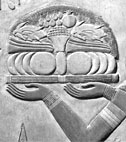|

Comment
on this story
What:
Pharaoh's Harvest
Where:
UT's McClung Museum, 1327 Circle Park Drive
When:
Friday, May 31 through August 18. Call 974-2144 for hours.
|
|

Egyptian plants star in art and photographs
by Heather Joyner
I admit that when I first heard about the McClung Museum's new show, I did not run for my calendar with a red marker. I am interested in plants and history and certainly art, but what I initially knew about Pharaoh's Harvest seemed too blandly "scientific" to provoke daydreams of a glitzy opening reception. Besides, terms like archaeobotany bring to mind less-than-thrilling visions of weed impressions in rock (if not the nether regions of an apartment-size oven I had as a sophomore in college).
Pharaoh's Harvest is indeed the result of methodical hours spent by archaeobotanist Hala Nayal Barakat and photographer Maryl Levine, but it is far more than an assortment of dusty display cases with snapshots and desiccated pods. It connects the distant past with our own time via plant life. A contemporary woman wearing a linen jacket, sipping wine, and tossing her hennaed hair as she reaches for a plate of chickpea salad might not feel remarkably tied to ancient Egypt, but she is. And this summer's exhibit shows us some of the reasons why.
Most of us have seen images from Egyptian temples and tombs that include abundant palms, lotus blossoms, and papyrus. Throughout the pharaonic era, trees and flowers were an ever-present motif in architecture. Flora in the above forms was more than decorative, however. It revealed a spirituality embedded in the natural world. Plants had religious significance and were then used as they continue to be used today—for healing, clothing, cosmetics, and other purposes beyond sustenance. Nile Delta excavations support claims that during the period of the 13th to 19th Dynasties (approximately 1784-1185 BCE), temples and palaces were surrounded by extensive orchards. Man-made structures and cultivated gardens within the existing landscape were meant to embody mythological notions and reflect a collective faith.
In People Of The Nile, archaeologist John Romer has noted that early Egyptian creation stories usually revolve around "the primeval waters of chaos, dark and formless...in the midst of these waters a mound of earth arose, like the hillocks that appeared in the flooded fields as the Nile's inundation subsided. This muddy mound was the stage for the dramas of creation and for the making of the gods who were the sky, the earth, the atmosphere; for the coming of the sun and of vegetation—all the elements, in fact, that made up the ancient world." It was believed that the sun had risen from the center of a floating lotus blossom, and (according to Romer) some people in remote areas still believe that a mound of "potent black silt" can produce spontaneous life. It therefore makes sense that plants nurtured by soil held sacred would be named for deities like Re and Osiris.
As for the Nile itself, its passage from an origination point in central Africa through a valley to the famed delta of Lower (northern) Egypt has been the life force behind civilization and empire. Its papyrus thickets were the source of the world's first paper, and that plant was also used for rope, fabric, food, and medicine. In her book titled The Garden In Ancient Egypt, Dr. Alix Wilkinson has written, "As the home of the cow goddess, Hathor, papyrus was the frontier between life and death...papyrus was offered to the gods for the produce of the marsh: birds, fish, and vegetation."
The material featured in Pharaoh's Harvest is organized according to ecological habitat. In addition to water plants (like papyrus and lotuses), legumes from the Nile's flood plain are examined. Broad beans and chickpeas were and are raised in fertile fields alongside onions, garlic, lettuce, and cucumber. Dates, figs, olives, and pomegranates thrive in today's orchards and gardens much as they did thousands of years ago. Each specific plant species is represented in photographs as well as within the context of ancient art. Centuries-old and recently preserved specimens are on view.
With support from the Robins Foundation and the Lewis Ginter Botanical Garden of Richmond, Virginia, Levine has created some gorgeous color prints. One example of art is a scene from the tomb of Nakht (dating back to the West Bank of ancient Thebes, now Luxor) showing a table with funerary offerings including grapes, figs, and cucumbers. Although ancient Egyptian art is called "a-spective" due to its lack of emphasis on realistic perspective, plants were rendered as accurately as possible. Wilkinson says, "The illustrations were not regarded as representations of a plant, they were the plant itself, waiting to be brought to life by supernatural means."
Pharaoh's Harvest, with its somewhat narrow focus, is not a blockbuster show by any means. It does, however, clarify which plants have survived millennia and what they have meant to generations of human beings. It also does so in a visually interesting way. If you've not visited the McClung for a while, be sure to check out the permanent exhibition on Ancient Egypt. Together with Pharaoh's Harvest, it provides quite a window into the past.

May 30, 2002 * Vol. 12, No. 22
© 2002 Metro Pulse
|